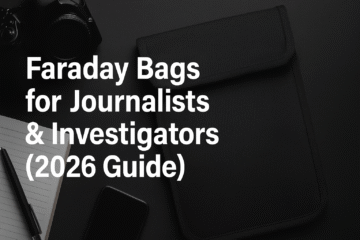Drone pilots in 2026 rely heavily on wireless systems—GPS, WiFi, Bluetooth, radio controllers, telemetry modules, and mobile devices used for flight apps. Faraday bags for drone pilots come into play. These wireless connections enable precision flying but also introduce vulnerabilities. Signal interception, device tracking, unauthorized access attempts, and data extraction now pose risks for hobbyists, commercial operators, and security professionals alike.
A faraday bag is one of the simplest and most effective tools for controlling these wireless risks. By blocking all incoming and outgoing radio signals, a faraday bag helps drone pilots protect flight logs, mission data, GPS coordinates, and controller integrations from unwanted access or interference. Whether flying recreationally or conducting high-stakes industrial or security operations, drone pilots can use faraday bags to secure devices during transit, storage, and field operations.
This 2026 guide explains how drone pilots benefit from faraday bags, which devices should be protected, and how to choose the right models based on your operational needs. For a broader product breakdown, see our main comparison guide here:
https://frequencyblockers.com/best-faraday-bags-2026/
Why Drone Pilots Use Faraday Bags in 2026
Modern drones rely on a network of interconnected wireless systems. These include:
- GPS L1/L5
- 2.4 GHz and 5.8 GHz controller links
- Bluetooth accessory modules
- WiFi-based flight apps (phones or tablets)
- UWB positioning
- Remote ID beacons (mandatory in many countries)
Each of these systems can reveal sensitive information when not properly secured.
A faraday bag allows drone operators to:
- Protect mission-critical flight data
- Prevent unauthorized access to controllers and tablets
- Disable automatic cloud syncing
- Secure devices during transport
- Avoid unwanted tracking through Remote ID signals
- Store sensitive devices offline
- Comply with confidentiality and regulatory requirements
For certain industries—such as inspection, surveying, law enforcement, energy infrastructure, and emergency services—these protections are essential.
Key Digital Risks Drone Pilots Face in 2026
1. Remote ID Exposure
Many jurisdictions now require Remote ID broadcasts that reveal:
- Drone serial number
- Location of the drone
- Location of the pilot
- Flight path information
A faraday bag for drone pilots fully blocks Remote ID transmissions when the drone is powered off and stored.
2. Interception of Flight Logs
Flight logs contain:
- GPS coordinates
- Altitude details
- Speed and pathing
- POI (points of interest)
- Mission timestamps
These logs can expose sensitive drone operations if synced automatically. A faraday bag prevents cloud-based apps from pushing or pulling data.
3. Unauthorized Access to Controllers & Tablets
Tablets and phones used for drone control often run:
- WiFi
- Bluetooth
- Location services
- Cloud-connected apps
- Screen-sharing services
- Telemetry uploads
When stored in a faraday bag for drone pilots, these devices are unreachable—preventing remote tampering or data exfiltration.
4. Signal Replay or Interference Attempts
Though uncommon for hobbyists, commercial drone operators face risks such as:
- Controller spoofing
- Replay attacks
- WiFi interference
- Unauthorized pairing attempts
A faraday bag protects sensitive gear when not in active use.
5. Tracking of Pilots and Ground Teams
Some drone operations—such as law enforcement, inspection, or investigative work—require privacy.
Faraday bags stop:
- GPS tracking
- Bluetooth discovery
- WiFi triangulation
- Identification through controller signatures
This helps maintain operational confidentiality.
Devices Drone Pilots Commonly Store in Faraday Bags
1. Phones & Tablets Used for Flight Apps
The most important devices to isolate when not flying, since they store flight logs and connect to cloud-based drone systems.
2. Drone Remote Controllers
Many controllers contain:
- WiFi modules
- Bluetooth modules
- GPS receivers
- Telemetry radios
These can still transmit when the drone is off.
3. Portable SSDs & MicroSD Cards
Drone footage is highly sensitive—faraday sleeves protect drives from wireless access attempts when used with smart drives.
4. Drone Batteries with Smart Chips
Some smart batteries broadcast limited diagnostic signals.
5. Backup Phones & Field Devices
Used for mapping or mission planning.
6. GPS Trackers & Beacons
Keeping them isolated is essential during transit or storage.
How Drone Pilots Use Faraday Bags in the Field
1. Protecting Devices During Transport
Devices remain isolated during travel to avoid automatic cloud syncing or network exposure.
2. Securing Devices During Sensitive Missions
Law enforcement, infrastructure inspection, and security teams often isolate devices to prevent location disclosure.
3. Storing Flight Data After Missions
Keeps logs offline until they can be reviewed in a secure environment.
4. Preventing Interference Between Flights
When taking breaks during multi-flight operations, storing controllers or tablets in faraday bags prevents unwanted pairing or re-connection.
5. Shielding Gear in High-RF Environments
Industrial facilities, energy sites, and airports can bombard devices with RF signals—faraday bags stop unnecessary interactions.
Key Features Drone Pilots Should Look For in a Faraday Bag
1. High Attenuation Across 2.4 GHz and 5.8 GHz
The most important frequencies for drone controllers and blocking by faraday bag for drone pilots
Recommended:
70–85+ dB attenuation for reliable protection.
2. Rugged Outer Construction
Drone operations can involve:
- Dust
- Moisture
- Rough terrain
- Rapid packing/unpacking
Ballistic nylon, PVC, or reinforced fabrics are ideal.
3. Roll-Top or Magnetic Closure
Best options for preventing RF leakage.
Roll-top = maximum sealing
Magnetic = fastest deployment
4. Proper Device Fit
Choose the correct size for:
- Controllers
- Tablets
- Phones
- SSDs
- Memory card wallets
Oversized bags can decrease shielding performance.
5. Professional Durability
Drone operators often travel frequently; gear must last through repeated field cycles.
6. Discreet Appearance
Especially useful for sensitive investigative or law enforcement drone work.
Best Faraday Bags for Drone Pilots (2026 Recommendations)
1. Mission Darkness Dry Shield
Best overall for drone controllers & tablets
- High attenuation
- Waterproof
- Roll-top reliability
- Large format sizes available
2. GoDark Faraday Bag (Tablet Size)
Best for shielding phones + tablets used for flight apps
- 85+ dB attenuation
- Magnetic closure
- Discreet and durable
- Excellent for GPS & WiFi isolation
3. Faraday Defense NX3 Series
Best for technical drone operations
- Triple-layer metallic mesh
- High stability across telemetry frequencies
- Laptop and controller-friendly sizes available
4. Silent Pocket Tablet & Laptop Sleeves
Best for low-profile field operations
- Minimalist designs
- Easy to pack into drone cases
- Good shielding for tablets & mobile devices
5. Mission Darkness Key Fob Shield
Best for securing smart keys used in fleet vehicles
Useful for law enforcement, security firms, or commercial fleets.
Faraday Bag Limitations Drone Pilots Should Understand
A faraday bag:
- Does not protect drones while in active flight
- Does not shield against low-frequency magnetic fields
- Does not secure physical access to the device
- Must be completely sealed to operate as intended
- Should be tested regularly to ensure performance
Faraday bags are essential for storage, transport, pre-flight, and post-flight privacy—not for in-air security.
Internal Frequency Blockers Links
Best Faraday Bags 2026
https://frequencyblockers.com/best-faraday-bags-2026/
Faraday Bags for Digital Privacy
https://frequencyblockers.com/faraday-bags-for-digital-privacy-2026-guide/
Faraday Bags Overview
https://frequencyblockers.com/faraday-bags/
References
FCC RF Safety Guide
https://www.fcc.gov/general/radio-frequency-safety-0
NIST Electromagnetic Shielding Overview
https://www.nist.gov/pml/electromagnetic-shielding-measurements
ITU Wireless Standards
https://www.itu.int/en/ITU-D/Statistics/Pages/default.aspx


